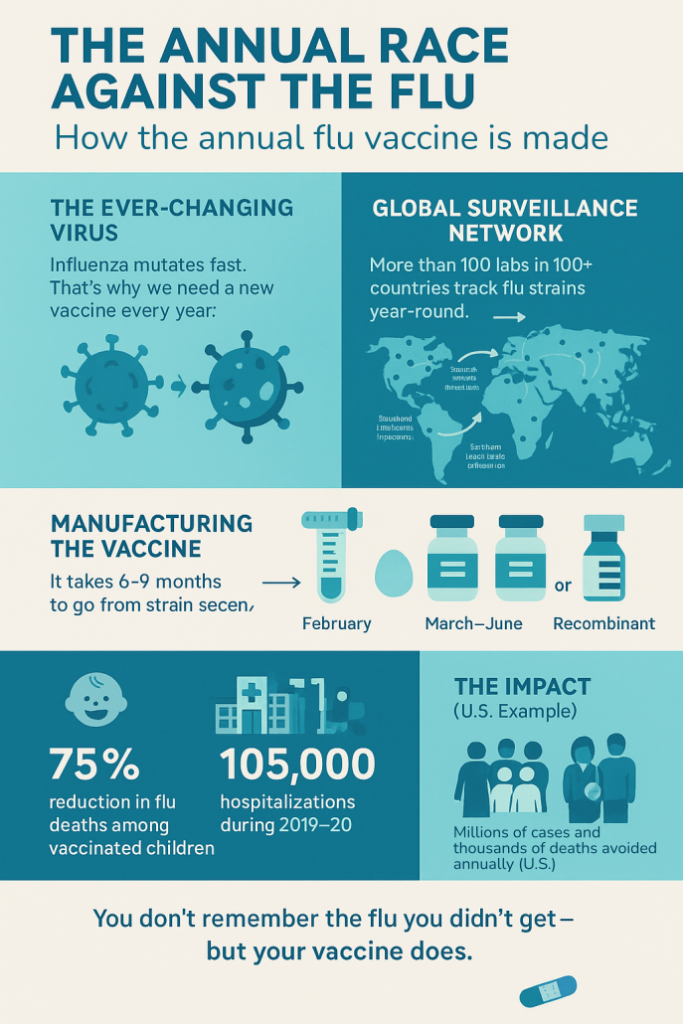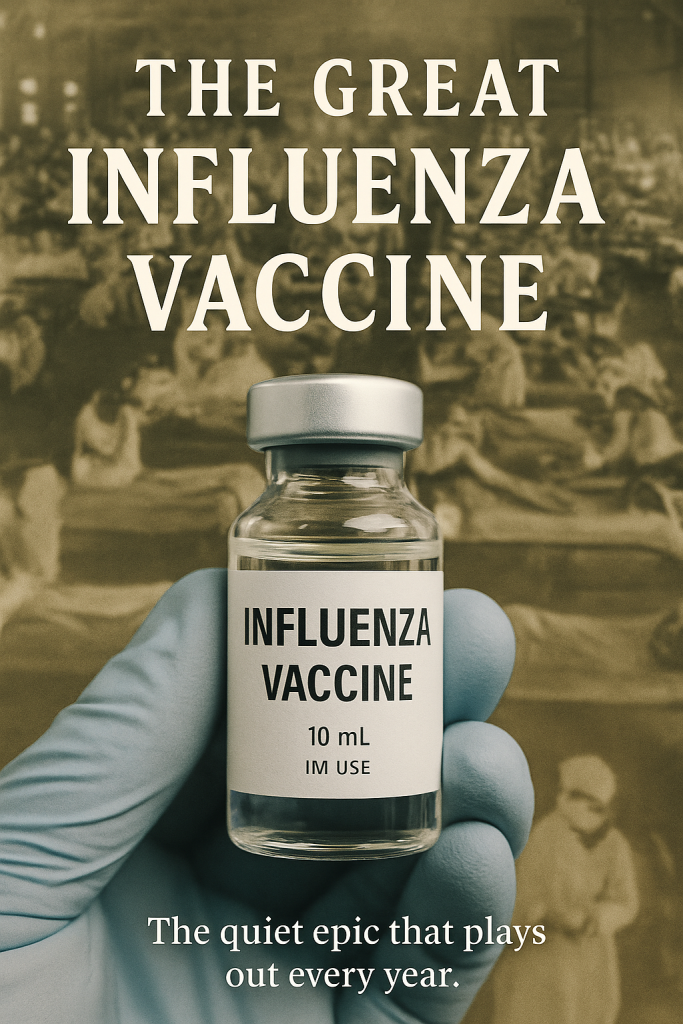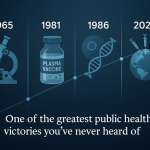How the Flu Shot Quietly Saves Thousands—Every Year
🦠 The Shape-Shifting Killer That Never Left
If you lived through the COVID-19 pandemic, you know what a deadly respiratory virus can do. But more than a century before that, the world was ravaged by another one: the 1918 influenza pandemic.
It killed an estimated 50 million people globally—more than World War I. It struck young, healthy adults with ferocity, filling lungs with fluid in a matter of hours. Entire families died within days. Morgues overflowed. Cities ran out of coffins. Life expectancy in the U.S. dropped by 12 years in a single season.
And the flu never went away.
While most years don’t bring pandemic-level devastation, seasonal influenza still kills 290,000 to 650,000 people globally every year. In the U.S. alone, it hospitalizes hundreds of thousands and kills tens of thousands—many of them children, the elderly, or people with chronic conditions.
And yet… most people shrug it off.

😷 The Flu Vaccine: A Quiet, Tireless Shield
Unlike the one-and-done shots that conquered smallpox or polio, the influenza vaccine must be remade every year. That’s because influenza is a shape-shifter—a virus with a talent for mutation. Each season brings new strains, new subtypes, new tricks.
And so, every year, scientists around the world work together in a high-stakes game of viral forecasting. They gather samples, run genetic analyses, and monitor flu activity in both hemispheres. Based on this global surveillance, they select the most likely strains that will dominate the next flu season.
Then manufacturers scramble to produce hundreds of millions of doses in a matter of months.
It’s a scientific feat that requires international coordination, predictive modeling, and logistical precision—and yet it receives less fanfare than a new iPhone.
The result? A simple shot that:
- Cuts your risk of serious flu illness by 40–60% (when well matched)
- Prevents millions of infections and doctor visits each year
- Reduces the severity of illness even when you still catch the flu
- Helps protect the most vulnerable by limiting spread
- Keeps hospitals from overflowing during peak respiratory season
👩🔬 The Pioneers Behind the Protection
The first influenza vaccines were developed in the 1940s, with help from Dr. Thomas Francis Jr. and his then-student, Jonas Salk (yes, that Jonas Salk—the future developer of the polio vaccine). Their early work was focused on protecting military personnel during World War II, where flu outbreaks could cripple entire units.
These early vaccines weren’t perfect—and they didn’t have to be. Even partial protection could mean the difference between recovery and pneumonia, between a mild illness and death.
Over the decades, the vaccine improved. The 1970s brought broader public rollout. The 2000s saw the introduction of quadrivalent vaccines, protecting against four different strains. Today, new mRNA-based flu vaccines are being tested—ones that could be faster to produce and more effective across variants.
Behind every flu shot is a small army of virologists, epidemiologists, statisticians, manufacturers, and logistics experts, racing the clock to outsmart the virus before it hits.
It’s one of the most coordinated, complex, and unsung efforts in all of medicine.
💡 But If It’s So Good, Why Do People Ignore It?
Unlike polio or measles, flu isn’t feared in the same way. It’s familiar. Routine. People say, “It’s just the flu,” forgetting that “just the flu” still kills tens of thousands in an average year.
And because the vaccine changes each year, and isn’t always a perfect match, its effectiveness varies—making it a frequent (and unfair) target of skepticism.
But here’s the truth: even when the flu vaccine isn’t perfect, it still saves lives.
- During the 2019–2020 season, it prevented 105,000 hospitalizations in the U.S. alone.
- In a bad match year, it can still reduce severity and prevent deaths in high-risk patients.
- In children, it cuts the risk of flu death by up to 75%.
And crucially, it helps prevent overwhelming hospitals during winter months—something we all learned to appreciate during the COVID pandemic.
🧒 Real People, Real Stories
Ask a pediatric ICU nurse about influenza, and their voice will lower. They’ll tell you about toddlers struggling to breathe, or teenagers placed on life support. They’ll tell you about pneumonia so fast it blindsides parents. And they’ll tell you what it feels like to watch a child die from a vaccine-preventable illness.
They know the flu shot isn’t perfect. But they also know it’s so much better than nothing.
You don’t remember the flu you didn’t get.
You don’t mourn the loved one who didn’t die.
That’s the burden of success: when vaccines work, nothing happens.
🌍 When the World Got Better—Quietly, Annually
The influenza vaccine doesn’t come with a global eradication campaign. There’s no ribbon-cutting ceremony, no dramatic victory speech. There’s just a steady drip of science, coordination, and effort—year after year.
And for all that work, it’s estimated that flu vaccines have prevented millions of deaths since their introduction. They’ve made it possible for us to send kids to school in the fall, visit grandparents in the winter, and keep our ICUs from collapsing during flu season.
This is what public health really looks like: not just miracle cures, but the quiet, relentless prevention of disaster.
🙌 Give It the Credit It Deserves
So the next time you see the little sign outside your pharmacy—“Get your flu shot here”—don’t walk past it. That shot represents decades of global science, coordination, and care. It might not feel heroic. But it is.
Vaccines don’t just end pandemics.
Sometimes, they stop them before they begin.
And that’s a story worth sharing.
Our ‘When The World Got Better’ Series
- When The World Got Better: Smallpox
- When The World Got Better: Polio
- When The World Got Better: Measles
- When The World Got Better: HBV
- When The World Got Better: Hib vaccine
- When The World Got Better: mRNA vaccines
- When The World Got Better: Influenza
🧠 For Additional Reading
- CDC: Influenza (Flu) Vaccine Information
https://www.cdc.gov/flu/prevent/index.html
Comprehensive guide to how flu vaccines work, who should get them, and annual updates. - World Health Organization: Influenza Vaccines
https://www.who.int/news-room/fact-sheets/detail/influenza-(seasonal)
Global perspective on seasonal flu, vaccine strategy, and international efforts. - NIH: Why Get a Flu Vaccine Every Year?
https://www.niaid.nih.gov/diseases-conditions/flu-vaccines
Explains how flu strains change and why annual vaccination matters. - Johns Hopkins Bloomberg School of Public Health: The Science Behind the Flu Shot
https://publichealth.jhu.edu/2022/the-science-behind-the-flu-shot
A plain-language explainer that tackles common questions and misconceptions.
Last Updated on June 30, 2025







